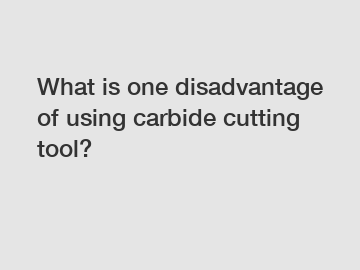What is one disadvantage of using carbide cutting tool?
Carbide cutting tools have long been a popular choice for machining and cutting operations due to their high hardness, wear resistance, and durability. These tools are made from a combination of carbide (usually tungsten carbide) and cobalt, making them extremely tough and able to withstand high temperatures and speeds. However, despite their numerous advantages, there is one disadvantage that users should be aware of.
One of the main disadvantages of using carbide cutting tools is their brittleness. While carbide is extremely hard, it is also quite brittle compared to other materials such as high-speed steel. This means that carbide tools are more susceptible to chipping or breaking if they are subjected to sudden impacts or excessive force during machining operations.
This brittleness can be a significant issue, especially in applications where the cutting tool is exposed to high levels of vibration or when cutting hard materials such as stainless steel or titanium. In these situations, the tool may not be able to absorb the energy from the cutting forces, leading to premature failure.

Another factor that can contribute to the brittleness of carbide cutting tools is improper tool geometry or inadequate tool design. If the tool is not properly designed for the specific cutting operation, it may not be able to dissipate heat efficiently or withstand the forces generated during machining. This can lead to thermal cracking or tool breakage, reducing the overall efficiency and productivity of the machining process.
To combat the brittleness of carbide cutting tools, manufacturers have developed a range of coating technologies that can increase the tool's toughness and resistance to chipping. These coatings, such as titanium nitride or titanium carbonitride, provide a protective barrier that can help to extend the tool's lifespan and improve performance.
Despite these advancements, users should still exercise caution when using carbide cutting tools and ensure that they are operating within the recommended parameters for their specific applications. This includes using the correct cutting speeds, feeds, and depths of cut, as well as employing proper tool handling and maintenance practices.
In conclusion, while carbide cutting tools offer numerous benefits in terms of hardness and wear resistance, their brittleness can be a drawback that users should be mindful of. By understanding the limitations of carbide tools and implementing best practices for their use, machinists can maximize the tool's performance and durability, ultimately leading to more efficient and cost-effective machining operations.
If you are looking for more details, kindly visit tungsten carbide drill bits manufacturer, TBM PARTS, China Carbide Rod Blank.
143
0
0


Comments
All Comments (0)